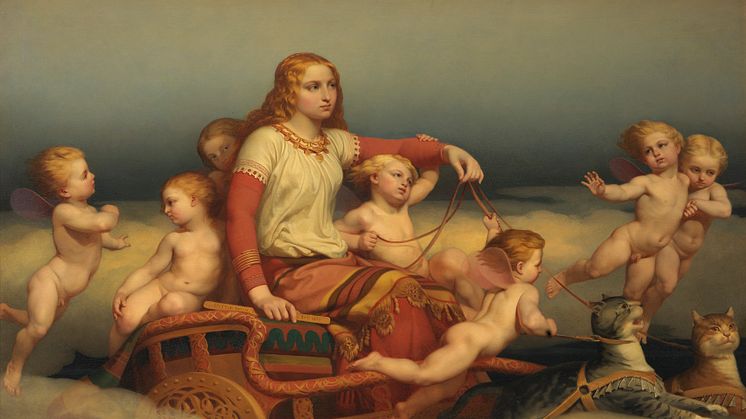
Press release -
The exhibition Nordic Myths opens at Nationalmuseum Jamtli on 18 May
This summer, the exhibition Nordic Myths will be presented at Nationalmuseum Jamtli. It focuses on visual storytelling in Nordic art during the 19th and early 20th centuries, a period when artists favoured subjects drawn from myths, fairytales and history. The exhibition includes a number of works by artists such as Carl Larsson, Elsa Beskow, Ernst Josephson and August Malmström, all from Nationalmuseum’s collections.
Nordic Myths are about visual storytelling in Nordic art during the 19th and early 20th centuries. It was an era before the advent of modern cinema, when art still had a largely narrative purpose. During this time, motifs taken from myths, fairytales and history were popular and used by many of the leading artists. The exhibition includes a number of works by artists such as Carl Larsson, Elsa Beskow, Ernst Josephson and August Malmström. In total, around 110 works are on display – mainly paintings and sculptures, but also drawings, graphics and applied arts. All the works in the exhibition belong to Nationalmuseum, which owns rich collections of Nordic art, especially 19th century Swedish art.
The artists of the 19th century were rooted in classical traditions. The gods of Greek and Roman antiquity and Renaissance frescoes were obvious starting points. One of art’s important tasks was to convey a morally edifying message. With the dawn of modern nationalism in the 19th century, it became increasingly important for artists to depict topics from national history. But in the Nordic countries there was also an interest in using Norse mythology and Old Norse fairytales as motifs. Instead of depicting Jupiter and Venus, painters and sculptors chose their Nordic counterparts, Odin and Freya. Today, some of these works of art bring to mind our contemporary popular culture, such as TV series such as Game of Thrones and the film adaptations of the books of J.R.R. Tolkien, productions that were not infrequently inspired by 19th century art peppered with Old Norse motifs. August Malmström’s illustrations for Tegnér’s Frithiof’s Saga are one example of this.
Some of the 19th century paintings with historical motifs have become true classics, images that have often been reproduced in school textbooks, among other things. Carl Wahlbom’s Death of Gustav II Adolf of Sweden at the Battle of Lützen is one such work. The fighting is chaotic and violent. Horses rear, soldiers fall, and gunpowder smoke and fog obscure swords and banners. The painting has helped to create the image of the king as a hero who dies for his country and for his Protestant faith. It is striking how many of the paintings with historical motifs have a tragic theme. Dying kings, violent battles, fires and disasters are common subjects.
Romanticism, which was the dominant artistic, literary, musical, and intellectual movement during the first half of the 19th century, involved an interest in folk traditions, fairytales and stories. Folkloric notions of supernatural beings such as trolls and fairies became a starting point for many artists. Nils Blommér painted the fairies dancing in summer meadows and evil water spirits among the moonlit waves. Evil water sprites also became a central motif for Ernst Josephson, who three decades later portrayed a violin-playing version of the creature as a sort of representation of the Romantic artist.
The years around the turn of the 20th century were a heyday for illustrated children’s books. One reason for this was the development of printing technology. Artists such as Elsa Beskow, Ivar Arosenius and John Bauer developed the medium of the illustrated children’s book into personal works of art in their own right. Using the decorative language of the Art Nouveau style, Bauer breathed new life into the Romantic motifs of fairytales. Sagas, myths and history were not only interesting for picture book illustrators. The national Romantic and Symbolist movements around the year 1900 also involved a general interest among visual artists in these types of subjects. One example is Richard Bergh, whose painting Vision depicts a historical event – Valdemar Atterdag’s fleet on its way to Visby in 1361 – as a kind of dream or fantasy image.
The exhibition Nordic Myths will be presented at Nationalmuseum Jamtli from 18 May 2021–18 April 2022. The exhibition’s curator is Per Hedström, Director of Exhibitions at Nationalmuseum.
Digital presentation for the press
The exhibition’s curator, Per Hedström, will give a digital presentation of the contents of the exhibition to the news media on 17 May at 10:00. The presentation will be held in Swedish and via Microsoft Teams. Register your interest no later than 14 March by writing to press@nationalmuseum.se. Prior to the presentation, a separate e-mail containing a link will be sent to your e-mail address.
Nationalmuseum Jamtli opened in the summer of 2018 and is an arena for art and design experiences in Östersund, where Jamtli’s award-winning pedagogy is combined with Nationalmuseum’s unique collections and knowledge. Nationalmuseum Jamtli has been made possible by the EU’s Regional Structural Funds, Östersund Municipality, Region Jämtland Härjedalen, and a broad collaboration with the business community, wherein the Swedish Postcode Lottery’s Cultural Foundation, Östersundshem, Länsförsäkringar Jämtland, Persson Invest, Jamtlis Gynnare, Jämtkraft, the Jämtland County Art Association, Diös, Attacus Invest, Lundstams Återvinning, Oscarson Invest, Toréns Entreprenad AB, the Jämtland County Savings Bank Foundation, the Gamla Östersund Association and the Gamla Östersund Women’s Association are important partners, both financially and through their other involvement. Assa Abloy and Bilbolaget have also made significant contributions.
For information to the press
Christina Wistman, Assistant Museum Director and Press Officer Jamtli, christina.wistman@jamtli.com, +46 (0)70 249 19 93
Hanna Tottmar, Head of Press Nationalmuseum, press@nationalmuseum.se, +46(0)8 5195 4400
Categories
Nationalmuseum is Sweden’s museum of art and design. The collections include paintings, sculpture, drawings and graphic art from the 16th century up to the beginning of the 20th century and the collection of applied art and design up to the present day. The museum building closed for renovation in 2013 and reopened in autumn 2018.

